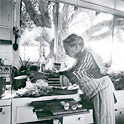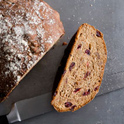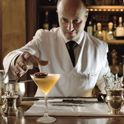Saumon Admiral
This dish is sometimes called saumon royale. Meh 2 tablespoons butter in a kettle large enough to hold the fish. Add 2 teaspoons chopped shallots and the peelings and chopped stems of 12 to 15 mushrooms, reserving the caps. Place the fish on top, add a few peppercorns, and sprinkle with ½ teaspoon salt. Add 1 pint white wine, or half wine and half fish stock. Cut a piece of paper the size of the kettle with a tiny hole in the center, butter one side of the paper, and place it. buttered side down, on the fish. Cover the kettle, bring to a boil, and cook in a moderate oven (350° F.) or on top of the range over medium heat or 35 to 40 minutes for a baby salmon or salmon trout of 3 to A pounds, allowing more time for a heavier fish.
While the fish is cooking, cook the reserved mushrooms in ½ cup water mixed with the juice of ½ lemon and 1 teaspoon butter for 5 minutes. When the bones separate easily from the flesh when tested with a knife, remove the fish from the kettle, cut away the skin and dark flesh, and place on a platter. Remove the mushrooms from their cooking liquor, keeping the liquor, place them on top of the fish, and cover with a piece of warm cheesecloth to keep the fish warm and moist.
Make the sauce as follows: Add the cooking liquor from the mushrooms to the liquid in the fish kettle and cook until reduced to about half the original quantity. Strain. Make a cream sauce by melting 2 tablespoons butter in a saucepan, adding 1 tablespoon flour, and cooking together until the mixture starts to turn golden. Add 1 cup hot milk and ½ cup cream and mix well with a wire whip as the sauce comes to the boil. Cook for 15 minutes, stirring occasionally. Add enough of the reduced cooking liquor from the fish to make a sauce that coats the back of a spoon. Correct the seasoning, add a few drops lemon juice, and strain through a fine sieve or muslin cloth. For a richer sauce, mix 3 egg yolks with ½ cup heavy cream and combine with the sauce. Bring back to the boil. but do not boil. Coat the fish with the sauce and garnish with 12 to 15 cooked shrimp, slices of truffles, croutons fried in butter, or crescents of puff pastry.
Saumon Joinville
Follow the recipe for saumon Admiral but garnish a little differently. Combine cooked mushrooms, shrimp, lobster, and truffles, all diced, with Newberg sauce (see November, 1949), arranging these like bouquets around the fish.
Another way of making the sauce is to reduce the liquor to one-third the original quantity and strain. Reheat and add a manié butter made by creaming 3 tablespoons butter with 1 tablespoon flour, swirling it in to blend with the liquid. Bring to the boiling point, but don't allow to boil. If the sauce is too thick, add a little heavy cream.
There are a couple of tricks in making sauces that I want to call to your attention. When making any of the white sauces, the more you stir and whip, the whiter and nicer it becomes. But the brown or dark-colored sauces you should stir only enough to keep the mixture from getting lumpy and scorching, using a wooden spoon very carefully or merely swirling the pan as the sauce cooks. If you stir or whip vigorously, the mixture is lightened so much that it loses its rich, attractive color. Thus, in making the red wine sauce for saumon Chambord, care should be taken to stir as little as passible. while saumon Admiral or saumon Joinville are improved by being whipped well during cooking. Another trick to remember is that the sauce which is thickened with beurre manié should never be boiled after the butter is added. Otherwise it will have a floury caste.
In making hollandaise sauce or mayonnaise for boiled salmon, there are a few important tricks. Many a cook has ruined these sauces consistently without ever knowing why. The trouble is that egg yolks and butter (or oil in the case of mayonnaise) can separate almost before you realize it. leaving a curdled mass instead of a smooth, beautiful emulsion. The thing is to add the butter or the oil very slowly at first, increasing the amount gradually as you continue adding, and never to stop stirring for a single minute. For hollandaise, do not let the water boil in the bottom of the double boiler. It should barely simmer while you are making the sauce. Mayonnaise should not be stored in the refrigerator because the extreme cold will cause it to separate. (See page 60.)


 Pinterest
Pinterest






